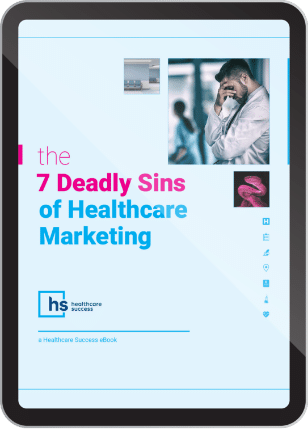Case History: How One Group Averted Disaster by Fixing Its Phone Inquiry Problems - and How You Can Do the Same
 It's a tragic and extremely costly story - and unfortunately one that we see all the time.
It's a tragic and extremely costly story - and unfortunately one that we see all the time.
Perhaps it has even happened to you.
Every day, hospitals and healthcare organizations across the USA invest hard-earned money into marketing, yet see zero new patients from their efforts.
Weeks and months of solitude go by, until finally their frustrations boil to the top:
"Stop everything. Marketing doesn't work!!!!"
Careful. They (and you) can easily make a very costly mistake here.
While poorly conceived and executed ads will generate zero results, oftentimes the problem lies not with the ads but with how the resulting calls are handled.
Wasted opportunity: Poorly handled phone inquiries may be costing your business many thousands of dollars in lost revenue each month
Here's a true case history to illustrate our point. (It's one of many, including hospitals and medical providers of nearly every stripe.)
A group we work with in the Southern US was utilizing external advertising to grow its medispa services.
However, when the ads hit the streets, the people at the front desk reported zero phone calls, and zero new patients. Of course, that's never good news.
Suspicious, we inserted unique tracking phone numbers into their ads, so that we could independently assess what was really going on. Our objectives:
- Track exactly how many calls were coming in from each ad.
- See what was happening to each of those calls.
- Record the calls for quality control and training.
- Make big improvements to the process so that we could skyrocket their ROI.
(See our article on this exciting new tracking technology Tracking the Source of New Patients to Maximize Your Advertising ROI)
As we suspected, the ads were in fact generating calls, but the front desk was dropping the ball. Here's what we found:
- Most of the time, the staff didn't pick up the phone at all. New inquiries were going straight into voice mail, or worse, the phone simply rang off the hook.
- The would-be patients never left voice mails. They simply hung up, never to call again. (Advertising generated inquiries have no patience for facilities that can't answer their inquiries during business hours.)
- Many inquiries came in after hours, and those too were forwarded to voice mail. (While ideally we'd like to forward after hours calls to an employee for some extra pay, voice mail is probably better than going to a bored answering service operator.)
- When new patients were lucky enough to reach a live person, they were either put on hold immediately, forgotten, treated rudely or given polite but very confused answers.
- And no one asked for an appointment.
We had to fix the "kinks in their hose."
At our live 2-day meetings, we often refer to these kinds of problems as "kinks in the hose."
No matter the volume of water (inquiries) that is trying to get through the hose (your front desk), nothing comes out the other end (new patients).
As is common, this particular location had a lot of kinks, so it took a few months and a couple of on-site trainings to fix them.
Fortunately, this particular practice was very coach-able, motivated and worked diligently with us to attack their problems. We are still making refinements, but here are some concepts we've successfully shared and implemented with them.
- Advertising-generated inquiries must be treated differently. We can't stress this point enough. Most offices are used to calls from doctor or patient referrals, and those calls are easy due to the built-in trust. New patients calling in from ads are always more skeptical and less forgiving because they don't know you yet.
- You need the right people on the phone. Doctors universally underestimate the skill set required for converting large numbers of advertising-generated calls into first visits. In busy practices, we demand sales skills. In this case, we had the wrong people and had to make changes. (We never like firing people, but the lifeblood of the practice was at stake.)
- You have to have effective operations. The staff is never 100% to blame. Most practices overwhelm the front desk with too many competing tasks, and this practice was no exception. As fate would have it, this particular practice received a very lucky break when a gifted Administrator emailed us her resume out of the blue. She turned out to be terrific, and has been instrumental in solving many real-world operational issues within the practice.
- There is nothing more important than a new patient inquiry. Period.
- The staff's main objective is to get the new patient scheduled for a first visit. The goal is not to educate, inform, answer insurance questions or make friends. The goal is to schedule a visit. Because this concept is counter-intuitive, you'll probably have to hammer it home with your staff over and over again.
- New patient ambassadors are great. When call volume warrants, we like to get calls off the front desk and to someone who really can focus on the call and sell them into their first visit.
- Scripting is essential. The staff has to know what to say. We recommend written scripts in the following format:
a. Establish rapport ("I am so glad you called. Can I ask your name?")
b. Track the source of the call ("Whom may we thank for referring you?")
c. Probe the reason for the call ("What was your specific need or problem?")
d. Establish value. ("You've definitely called the right place. You see, our doctor...")
e. Close for an appointment ("What works best for you, Monday morning
or Tuesday afternoon?")
f. Answer objections (Especially no time, no money, too expensive, no need
and "I will call you back.") - Training can rocket your success. There are a lot of moving parts to this, so proper on-site training and ongoing coaching can make a big difference. Beyond teaching the staff HOW to change their ways, we have to sell them on WHY they should. Many employees suffer from inertia or the wrong culture ("I got into healthcare because I don't want to be a salesperson"), so clearly some practices are not "easy fixes." In any event, proper training can make a world of difference.
The astounding total cost of poor inquiry handling
Our aforementioned practice discovered its problems and tackled them head-on. We're not completely finished yet, but most of their biggest problems have now been solved, and almost all inquiries now result in a new visit. And that will have a BIG impact on their bottom line.
Lots of kudos to them.
However, the vast majority of practices out there who gave up on marketing unknowingly suffer from a "quiet disaster."
They don't even know whether their problems were due to ineffective ads or poor inquiry handling. They just know it "didn't work," so they stopped marketing all together.
And that's tragic because their wasted advertising expenditure was peanuts. Their real cost is the opportunity cost.
For example, let's say a given practice invested $10,000 in advertising that should have generated $50,000 in long-term profits. Or that $50,000 in advertising should have generated $250,000 in profits. Or their $250,000 marketing budget should have brought in $1 million in profits.
Because they quit, they walked right by a huge revenue opportunity that could have paid big dividends year after year after year.
Take action now
As you can see, this is an important issue, so we highly recommend you take action to ascertain whether or not you suffer from these problems, and if so, begin fixing them right away.
The cost of inaction is just too great to bear.
If you'd like our help, call (800) 656-0907.
Note: See also Phone Skills Can Make or Break Your Practice and Tracking the Source of New Patients to Maximize Your Advertising ROI








